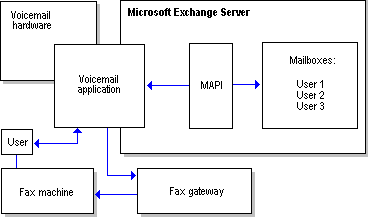 To use a voice mail server
To use a voice mail server
| Platform SDK: Exchange Server |
A voice mail server stores messages and makes them available when the user dials into the system. The user communicates with this application in the following manner:
 To use a voice mail server
To use a voice mail server
The Windows NT account of the voice mail application is assigned read-only access to mailboxes. In other words, an administrator grants the privilege of reading all the messages in the mailboxes to this account. When the voice mail application logs on as the Windows NT account, it can read all the mailboxes on the messaging site. (Applications of this type are granted some of the rights normally reserved only for administrators.)
The following diagram shows interactions of this voice mail system.

Architecture of a voice mail application
If a user chooses to send a message by fax, the application must forward the message to a fax server. First, MAPI creates the message, then assigns a destination address to the message, using FAX as the address type (FAX:xxxxx). The phone number of the destination fax machine is supplied as the address value. The message is submitted by calling the MAPI IMessage::SubmitMessage method.
After the message is submitted, Microsoft Exchange Server routes it to the FAX gateway, which puts the message into FAX format and sends it to the destination fax machine.
This voice mail application shares several other characteristics with common types of server applications.